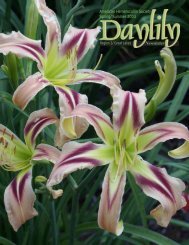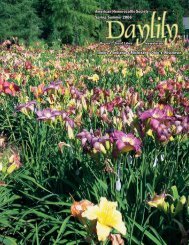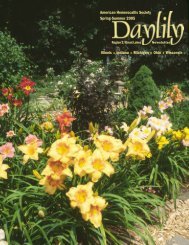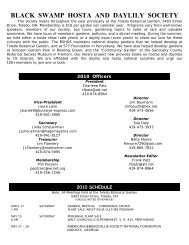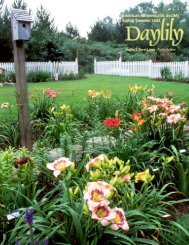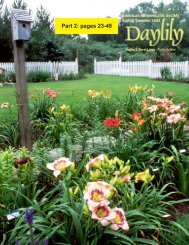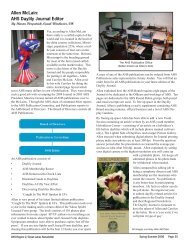Pages - AHS Region 2
Pages - AHS Region 2
Pages - AHS Region 2
You also want an ePaper? Increase the reach of your titles
YUMPU automatically turns print PDFs into web optimized ePapers that Google loves.
<strong>AHS</strong> <strong>Region</strong> 2/Great Lakes Newsletter<br />
<strong>Region</strong> 2 Symposium – Year 2000<br />
Cleveland, Ohio<br />
On behalf of <strong>Region</strong> 2, I wish to extend appreciation for a job well done to Curt Hanson, host of our 8th annual<br />
<strong>AHS</strong> <strong>Region</strong> 2 Symposium, March 3-5 in Cleveland, Ohio. Curt provided us with a great lineup of speakers<br />
whose subjects were varied. Dwight Alsbach, curator of slides and noise makers, provided the entertainment<br />
enjoyed by all, and Registrar Juli Hyatt was the glue that binds an event together. Plans are already being<br />
formulated by Curt for Symposium 2001 (the true millennium). The following is a recap of events, and we<br />
certainly hope this inspires you to make plans to set next year’s date aside and attend. Thank you Curt, Juli,<br />
Dwight, and all who attended this informative, uplifting, fun-filled event.<br />
Mary Milanowski<br />
A Presentation by Dr. . Kevin Vaughn<br />
It’s A Small World After All…..<br />
Breeding Miniatures<br />
Dr. Kevin Vaughn informed the <strong>Region</strong> 2 crowd<br />
that growing daylilies in the Mississippi delta<br />
was easy, since all of us Midwesterners sent<br />
our best soil to the delta for the cultivation of plants.<br />
Originally from New England, Kevin has been interested<br />
in miniature daylilies for quite some time, and<br />
has developed a lot of his ideas and techniques about<br />
daylily hybridization from his work with food crops for<br />
the USDA. The three main characteristics that Kevin<br />
finds appealing in a miniature daylily are:<br />
1.) density of blossoms, 2.) compact flowering, and 3.)<br />
the “look of a bouquet,” which are all related to the<br />
propensity of miniature daylilies to gain clump strength<br />
rather quickly.<br />
Dr. Vaughn has developed both miniature diploids and<br />
tetraploids, with the most promising diploids being<br />
converted by Kevin for use in his tetraploid programs.<br />
In the round diploids, Kevin showed seedlings from<br />
his many different lines of breeding that were developed<br />
from his introductions such as BEAT THE BUG,<br />
a 3 ½ " bright yellow with a red eyezone (1996; BEAT<br />
THE BARONS X SILOAM DOODLEBUG); SEE MY<br />
ETCHINGS, a 3 ½ " cream with a blue-violet eyezone,<br />
ala Elizabeth Salter (1996; SILOAM BO PEEP X<br />
WITCHING HOUR); and DELTA BELLE, a 4" clear<br />
pink (1996; TRUE HEART X SILOAM APPLE BLOS-<br />
SOM). One kid in the blue-violet eyezone program, D-<br />
115-1, which is out of (EXOTIC KISS X (SUMMER<br />
ECHOES X SILOAM TINY TIM) has a very prominent<br />
spiky “blue eyezone” on a white petal. It appears<br />
as if the eyezone has been pulled with a thin painter’s<br />
brush up onto the petals at 1/8" intervals around the<br />
Page 20 Spring/Summer 2000<br />
by Greg McMullen, Indiana<br />
Dr. Kevin<br />
Vaughn<br />
holding the<br />
<strong>AHS</strong><br />
Publication:<br />
Some Basic<br />
Hemerocallis<br />
Genetics<br />
by J. Norton.<br />
petal. Another plant, FAIRY BALLET, which is from<br />
the DELTA BELLE line, is one of the tiniest plants<br />
that Kevin has produced to date, with a 12" scape and<br />
2 ½" diameter blossoms. Most of these lines owe a debt<br />
of gratitude to Pauline Henry, who has paved the road<br />
for many of Kevin’s successes.<br />
Kevin is also exploring miniatures with prominent edges<br />
and no eyes, from crosses involving plants such as BEAU-<br />
TIFUL EDGINGS (Copenhaver 1989) and RAINING<br />
VIOLETS (Wild 1983), with some successes such as an<br />
unnamed seedling that was yellow with a pink edge.<br />
Kevin also spends time daubing with miniature doubles,<br />
which are also called “popcorn doubles”. These seedlings<br />
have been developed from such notable award winners<br />
such as SILOAM DOUBLE CLASSIC (Henry 1985)<br />
and JANICE BROWN (EC Brown 1986) crossed with<br />
lesser known plants such as BUBBLY (Joiner 1986) and<br />
(continued on page 19)



